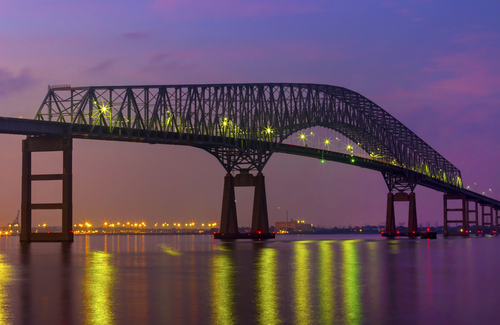
Vessels previously bound for the Port of Baltimore will head to other East Coast ports, officials said, after maritime traffic was diverted due to the collapse of the Francis Scott Key Bridge when it was struck by a container ship on Tuesday.
Officials with the Port of Baltimore said vessel traffic into and out of the port is shut down until further notice. However, the port is still processing trucks inside its terminals.
A 10,000-container capacity vessel, Dali, a Singapore-flagged ship, was headed out of the Port of Baltimore on Tuesday around 1:30 a.m. when it collided with the bridge. The bridge carries I-695 across the Patapsco River, southeast of Baltimore.
The 17th biggest port in the nation in 2021, the Port of Baltimore ranks first in the United States for its volume of automobiles and light trucks, and for vessels that carry wheeled cargo, including farm and construction machinery, Maryland Gov. Wes Moore said last month.
The Port of Baltimore is critical to Maryland’s state economy. According to the Maryland State Archives, the port supports 15,330 direct jobs and 139,180 jobs connected to port work. The port also generates more than $395 million in taxes and $2.6 billion in business income. It serves over 50 ocean carriers making nearly 1,800 annual visits.
Gov. Moore said the state was working closely with the federal government in response to the bridge collapse.
“My office is in close communication with U.S. Transportation Secretary Pete Buttigieg, Baltimore Mayor Brandon Scott, Baltimore County Executive Johnny Olszewski, and the Baltimore Fire Department as emergency personnel are on the scene following the collapse of the Francis Scott Key Bridge,” he said in a statement. “I have declared a State of Emergency here in Maryland and we are working with an interagency team to quickly deploy federal resources from the Biden Administration.”
MarineTraffic noted Tuesday morning that about 40 ships, including 34 cargo vessels were headed to Baltimore. However, by Tuesday afternoon, officials said vessels previously bound for Baltimore would be headed to New York, Virginia and other ports along the East Coast.
According to the Port Authority of Baltimore, the port’s five public and twelve private terminals handled record amounts of cargo last year, handling 11.7 million tons of general cargo, up from 11.3 million tons in 2022. The port handled 52.3 million tons of international cargo valued at $80.8 billion last year.
President Joe Biden said he had convened senior officials on Tuesday morning for a briefing on the incident.
“We’re going to work with our partners in Congress to make sure the state gets the support it needs,” he said in a press conference on Tuesday. “It’s my intention that the federal government will pay for the entire cost of reconstructing that bridge and I expect Congress to support my effort.”
Biden said it would take some time to reconstruct the bridge, but that he’s directing the federal government to “move heaven and earth” to reopen the port and rebuild the bridge “as soon as humanly possible.”
Owners and managers of the Dali said the vessel collided with one of the bridge’s pillars while being piloted by Baltimore harbor pilots, as is customary. Crew members of the vessel said they lost power and propulsion prior to colliding with the bridge, officials said. No one on the vessel was injured.
“All crew members, including the two pilots have been accounted for and there are no reports of any injuries. There has also been no pollution,” the vessels owners and managers said in a press release. “Whilst the exact cause of the incident is yet to be determined, the ‘DALI’ has now mobilized its Qualified Individual Incident response service. The U.S. Coast Guard and local officials have been notified, and the owners and managers are fully cooperating with federal and state government agencies under an approved plan.”
The National Transportation Safety Board said at a press conference that it was investigating the incident.